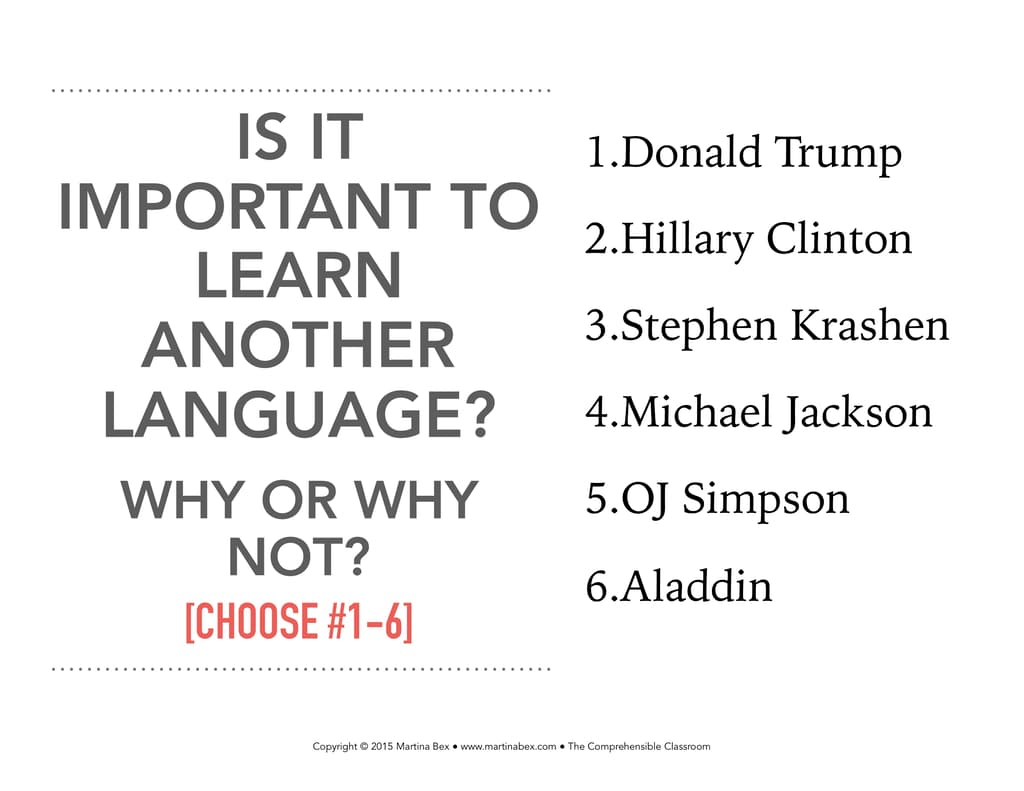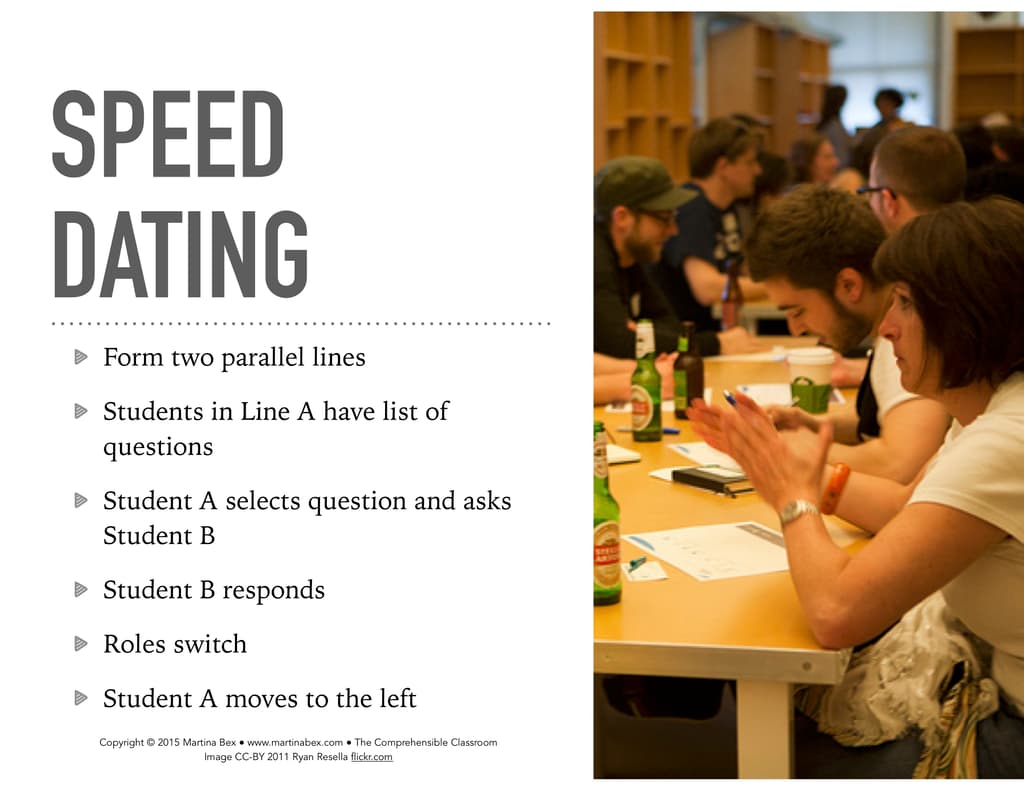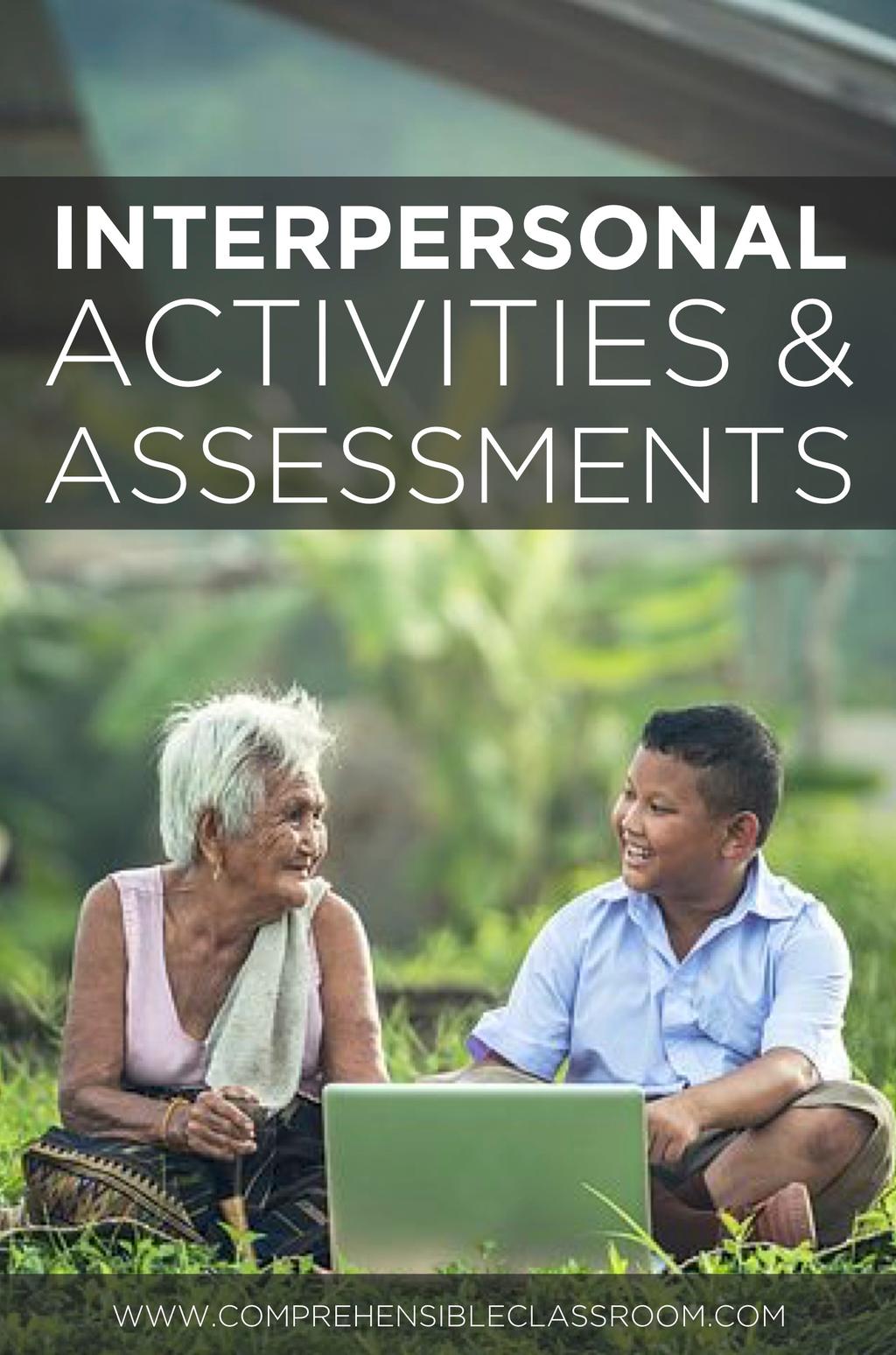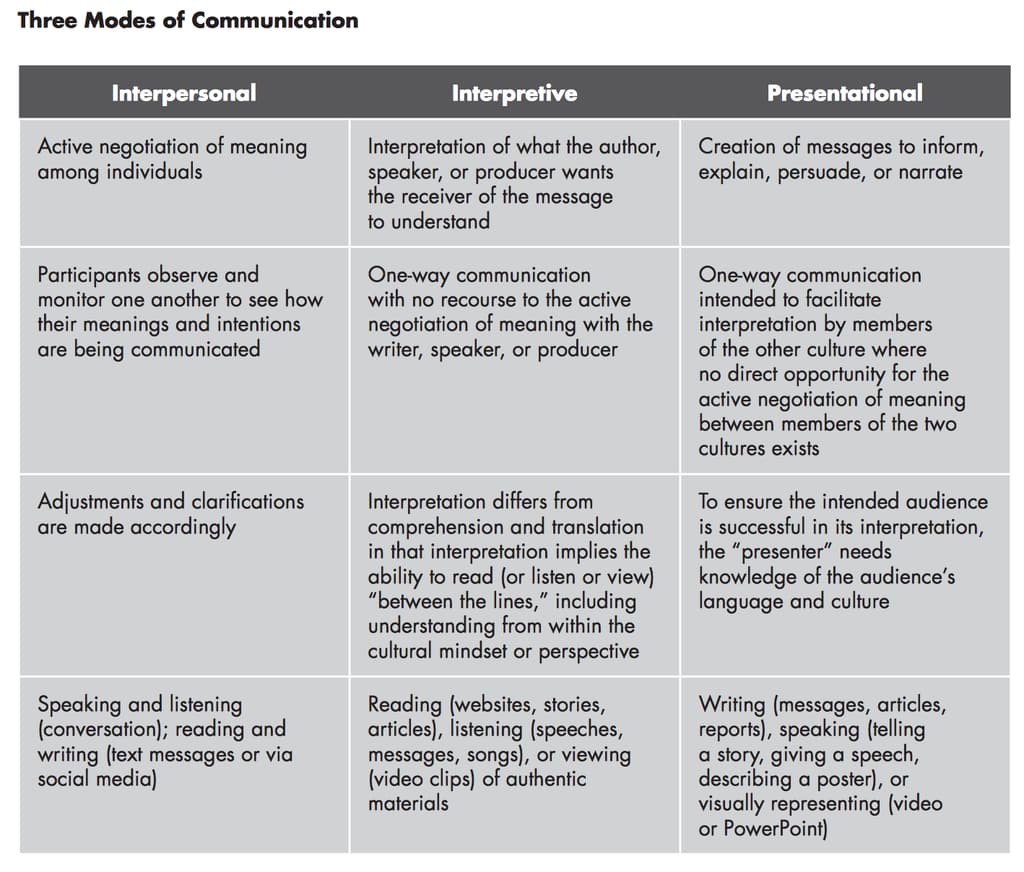So #langchat tonight was crazy. We celebrated "Throwback Thursday" by using the old "free-for-all" format in which a topic is given at the beginning, but the conversation is not moderated. #langchat has grown significantly, and while I prefer the free-for-all format to the moderator Q - participant A format, it was clear tonight that there are just too many participants for a free-for-all to be successful.
As I was making dinner and trying to get my brain to un-clench from the stress of trying to keep up with the conversations, I realized why tonight's topic was truly the perfect topic to address in the old format.
You see, tonight we discussed interpersonal speaking assessment. And what is interpersonal speaking but spontaneous communication between two or more parties? It can get messy: we miss pieces of the conversation, we misinterpret other things, we don't express ourselves well, we are misinterpreted...oh yeah and sometimes we communicate successfully!
Story of tonight. The "new" #langchat format, where the moderators ask questions and the participants respond, is not interpersonal communication. At times it tends in that direction, but by and large it ends up being two ongoing presentations that happen to be related. What I loved about tonight is that I felt like for the first #langchat in a long time, the participants really had a conversation going! We were trying to work through the intricacies of interpersonal communication together, and it felt like collaboration; not presentation. The Q/A format tends to create an atmosphere of show and tell--which is great because the participants have so many great ideas--but it's not the same as what happened tonight.
So what were we trying to work through? Well, the conversation ended up centering on Assessment of Interpersonal Speaking at the Novice level: should novices be assessed (formally--graded) on their Interpersonal Speaking ability, and, if so, how? My takeaway from tonight was that I needed to spend some time looking at proficiency guidelines and to grill Scott Benedict when I see him this weekend at AFLA about his take on the subject, since he's my favorite Proficiency Based Assessment guru :) Well, a few hours have passed, and I've got some initial findings and conclusions to share with you. (And, at the bottom of the post, I'll share links to some Interpersonal Speaking activities because let's face it--you need stuff to use in class, not just stuff to make your brain hurt!).
My first and favorite new find on Interpersonal communication—and specifically for novices—is this guide from the Ohio Department of Education. I actually cannot believe that a state DOE would ever spend so much time and effort to create such a specific guide, but there it is! They show the three dimensions of Interpersonal communication: comprehensibility, quality of communication, and interculturality.

What I care about here is the fact that Interpersonal speaking is spontaneous by both parties by definition! Knowing that communication must be spontaneous makes me think that Novices (at least Novice Lows and Novice Mids) are incapable of true interpersonal communication (oh my, I am gasping at my own self for thinking that!). I mean, let's look at ACTFL's proficiency guidelines for Novice Low speakers:
Speakers at the Novice Low sublevel have no real functional ability and, because of their pronunciation, may be unintelligible. Given adequate time and familiar cues, they may be able to exchange greetings, give their identity, and name a number of familiar objects from their immediate environment. They are unable to perform functions or handle topics pertaining to the Intermediate level, and cannot therefore participate in a true conversational exchange. - Page 8, ACTFL Proficiency Guidelines, Copyright © 2012 by The American Council on the Teaching of Foreign Languages, Alexandria, VA
Well, shoot! Did you catch it?? You have it right there, straight from the source! Novice Lows... "cannot [...] participate in a true conversational exchange". So I'm not crazy! Which begs the question, why in the world are we holding them accountable--grading them--on something that they shouldn't technically unable to do?? While the guidelines do not explicitly state that Novice Mid and Novice High speakers cannot participate in true conversational exchanges, they are very clear that Novice speakers at all sub-levels are very difficult to understand and only able to produce short, memorized chunks of speech. For more details, we can look to ACTFL's Performance Descriptors. And while we are examining ACTFL's publications (since they should be our go-to when determining how to assess our students), let's see how they describe Interpersonal Communication:
Again, we see this idea of "active negotiation of meaning", which disqualifies any kind of conversation in which one or both sides is predetermined. And since Novices can only function with memorized (predetermined) chunks, I am further convinced that we should not be grade Novices on their Interpersonal Speaking performance.
I think that it is inaccurate to say that Novices do not have interpersonal speaking ability; after all, there are descriptors for it in all of ACTFLs proficiency publications. However, the ability is extremely limited and does not appear to have yet become an ability in its own right: it is still a sum of its collective parts (the ability to comprehend and the ability to produce), but it is not yet greater than the sum of its parts! It is not "its own beast": it is comprehension (interpretation) and production, and the negotiation--the process component--has yet to develop.
As I searched the Internet to see how other teachers are assessing Interpersonal speaking at the Novice level, I found quite a few good rubrics--but none of them gave me the "missing link" that could convince me that I should create a separate category for Interpersonal speaking in my gradebook. Here are two quick examples:
- I love the feedback section at the bottom of this rubric—where students GLOW and where they need to GROW. What seems to be missing is a measure of their ability to understand the question being asked—as is, it looks no different than a presentational rubric, since it focuses only on production and the ability of someone else to understand what the student says.
- In this speaking assessment for Novice Lows (available in a bunch of different languages!), we see the true expected ability of a novice speaker. Notice that everything must be memorized: the student should have memorized the questions that s/he is expected to interpret and his/her standard (or possible standard) responses for the questions. Zero creativity is involved. This assessment appears to be designed to be speaking between the teacher and the student, which was a topic of discussion in tonight’s #langchat. Since Novice learners are not expected to be able to negotiate meaning, they really do need to hear correct language in the questions, and that cannot be guaranteed in student-student interactions. But if the teacher is being strategic in the questions and speaking in a way that the student should absolutely be able to understand, then can using a pre-determined list of questions even qualify as interpersonal communication? It would seem to me that the “interpersonal” component wouldn’t come into play until follow-up questions are asked—questions that the questioner hadn’t premeditated—and then novices are not supposed to be able to understand and respond because those questions would most likely not have been memorized.
So my preliminary conclusion for tonight is that we should NOT formally assess Novice learners on their Interpersonal Speaking ability. If you were at my assessment session at iFLT this summer, you might remember that I said that when I return to the classroom one of these years, I'd break down my speaking category into "presentational speaking" and "interpersonal speaking". Well, I have changed my mind and will keep it the way it is (at least in my beginner language courses). All that as a result of Interpersonal communication on #langchat tonight and some follow-up Interpretation of Internet resources. But please, let's continue the conversation--nothing is set in stone here!
Should my students practice interpersonal communication?
Of course, deciding that I won't grade students on their Interpersonal speaking ability doesn't mean that I won't be giving them opportunities to practice and develop it, all the while giving them formative feedback. So first, let's deal with formative assessment and feedback. Thomas Sauer (@tmsauer1) asked this question several times tonight:
So, forgetting about summative assessment (since I am throwing it out the window for now), let's talk about formative assessment and feedback. How can I get a pulse on my students' developing Interpersonal Speaking ability and communicate to them what their pulse was? The best solution that I found to this dilemma (as a teacher with 175 students each year) was to use these speaking cards.

Use speaking cards with built-in rubrics aligned with ACTFL proficiency guidelines to assess interpersonal speaking quickly!
I'll let you read the instructions that are included in the file, but basically I just walk around the room and make notes on the cards that belong to whichever students I happen to listen in on. If I don't get through everyone in one day, no problem--I just pick up the stack during the next communicative activity and continue on with the remaining students. A good and accurate summative assessment should never indicate a different proficiency level than its formative counterparts, so it doesn't really matter that I am collecting data from different activities. Students will demonstrate their true ability in informal situations. By recording data on several different instances for each student, I can identify "outliers": instances in which students--for whatever reason--did not demonstrate their true ability.
So that's the how; here's the what: some different Interpersonal speaking activities that you can use in class. Remember that Interpersonal speaking requires spontaneous, two-way interaction. In many of these activities, students are working with prescribed questions, so the Interpersonal speaking doesn't come into play until students ask follow-up questions that they come up with on-the-spot. Because Novices' ability to create follow-up questions and respond to unrehearsed questions from their classmates is extremely limited, you are going to be examining the building blocks of that skill (listening comprehension and speaking production) more than the skill itself as you formatively assess these activities. Mostly, you're just giving them an opportunity to develop their confidence and competency for conversational speech.
ACTIVITIES TO PRACTICE INTERPERSONAL SPEAKING:
Here are some that have been shared before:
As the name of this activity implies, Simultaneous Presentations involve the Presentational mode first (students are sharing something that they have prepared with a series of classmates). For it to become an interpersonal activity, the 'audience' must respond in some spontaneous way to the presenter, and the presenter must respond back with unprepared speech. What I like about Simultaneous Presentations is that students are provided with something that they can talk about, and it is different each time that students switch partners.
Fan N Pick is one of my favorite Kagan structures, and while the first time that you use it with your students is a little confusing, it is well worth the effort to make sure they understand how it works. I love that all group members have roles and that it is very low-stress. Once again, for this to become interpersonal, that follow-up question or reaction piece is key: otherwise, it's a presentation activity.
Collective interviews are really fun and a great way to get responses from all students in the class without the teacher having to ask and listen to a zillion responses. Remember--interpersonal requires spontaneity, so the interviewer students must be asking follow-up questions and reacting in the target language to what their interviewees are saying!
Quiz Quiz Trade works with prepared questions (each student has one when the activity begins). For that reason, Quiz Quiz Trade is an interpersonal speaking activity if and only if each partner asks a follow-up question before partners switch cards and part ways.
...and here are some new ones that I share in my Assessment for Acquisition workshop:


ROLL A ROLE
Roll a role is a great activity to use after you have been exploring a topic in your classes; in particular, a topic on which there are at least two standard opposing opinions, or perhaps more.

Students are assigned a 'role' at random by the roll of a die, and then they are given a question to discuss. The catch is that they have to discuss the question 'in character'; from the perspective of the role that they rolled.
Here is an example: students are assigned one of the six roles below, and from that person's perspective, they must discuss with their partner (who has rolled a different role) whether or not it is important to learn another language.

SPEED DATING
I love speed dating because it gets students moving (but not too much, ha!) and it allows students to talk with many different partners throughout the course of the activity.
When I do speed dating activities with my students, I have them form two parallel lines that are facing each other. Each student is partnered with the student that they are immediately across from, and then I give them a topic to discuss. Sometimes, I give students a list of questions and they can choose from any of the questions on the list to talk about; but if you are really going for interpersonal mode then you need to make sure that the question asker is coming up with their own follow-up questions and not just reading pre-created language.
After a minute (or even less!), I ding my bejeweled teacher bell, and one of the lines moves to the left, so that each student is now facing a new partner.
Repeat!

IN SUM
REMEMBER: unless spontaneous, two-way interaction (that means spontaneous on the part of each party involved) is taking place, it is not truly an interpersonal speaking activity. HOWEVER, even without that spontaneous, two-way interaction, all of these activities will build students' confidence and competence in the building blocks of Interpersonal communication.
Thank you, and goodnight.







